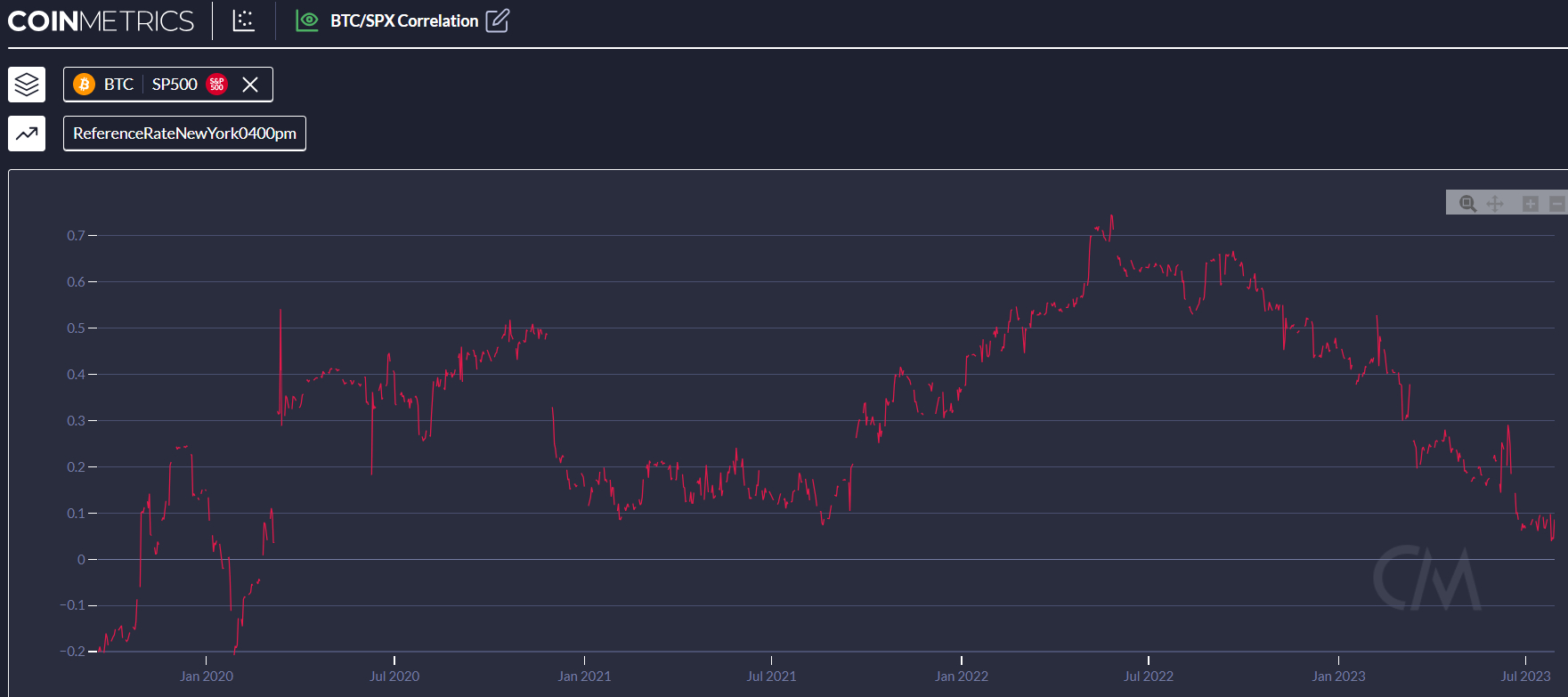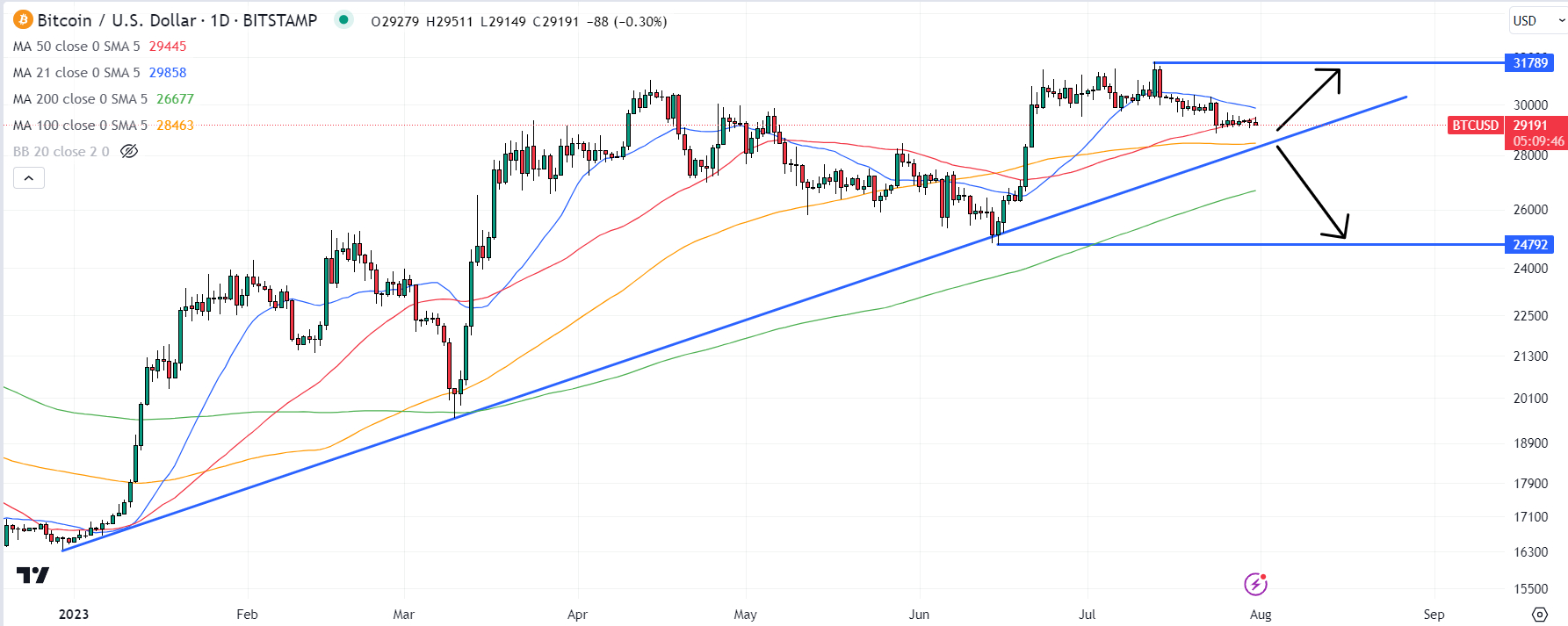Bitcoin (BTC), the world’s first and largest cryptocurrency by market capitalization, is on course to close out an uncharacteristically weak July lower by about 4% and stuck within familiar ranges in the low $29,000s.
Month-end positioning could introduce an element of chop into the market, but bitcoin trading conditions are expected to remain fairly subdued given an influx of key US economic data releases later in the week, including ISM PMI survey results, JOLTs Job Openings data and the official jobs report for July.
Bitcoin has been broadly unimpacted by macro in recent months.
Instead, the BTC market has seemingly been more focused on themes like 1) institutional adoption amid the recent wave of spot bitcoin ETF applications from Wall Street heavyweights like BlackRock and 2) the US Security and Exchange Commission (SEC)’s ongoing regulation by enforcement push.
But if this week’s US data continues to strengthen the “soft landing” narrative – the idea that the Fed can get US inflation under control without causing a recession – this could be a plus for risk assets.
Tech stocks have been rallying in recent weeks, with the Nasdaq 100 index only within around 6% of its all-time highs.
If the tech rally extends this week, that could create tailwinds for BTC.
While the correlation between BTC and tech stocks has weakened substantially in recent months, it has normally been very strong since 2020.
As per CoinMetrics, bitcoin’s 60-day Pearson correlation to the (admittedly less tech-dominated) S&P 500 was last around 0.1 (very weak, but still positive), down from highs above 0.70 in H1 2022.

More Anguish for Bitcoin This August?
Having performed poorly in July, bitcoin is on the backfoot heading into what has historically been its second weakest month of the year.
As per bitcoinmonthlyreturn.com, since bitcoin pricing began in late 2010, the BTC price has fallen in seven out of 12 Augusts.
The cryptocurrency’s mean return in August is still slightly positive at 0.69%, which is way below its average monthly return since price history began at over 11% per month.
Despite downbeat historical precedent, investors seemingly remain modestly upbeat on bitcoin’s near-term outlook.
At least, that’s the takeaway from pricing in the bitcoin options market.
The 25% delta skew of bitcoin options expiring in 7, 30, 60, 90 and 180 days all remain above zero, as per data presented by The Block.

A 25% delta skew of above zero means that bullish Bitcoin call options are trading at a premium versus equivalent bearish put options, suggesting investors disproportionately demand the former.
While the excessive optimism of late June/early July has clearly waned, the 25% delta skew of these Bitcoin options of different expiries remain above their pre-BlackRock spot bitcoin ETF application levels back May and early June.
All said investor positioning heading into August suggests a recovery to yearly highs in the upper $31,000s is seen as more likely than a drop back to May lows in the $25,000s.
Here is the Key Support Zone to Watch
Chart analysis (for now) supports the bullish thesis.
Bitcoin’s strong 2023 uptrend remains intact for now, though the cryptocurrency is approaching a test of key support in the mid-$28,000s that would put this uptrend to the test.

If the world’s largest cryptocurrency by market cap does find support here, that would strongly suggest that a retest of yearly highs is on the cards.
If it breaks the 2023 uptrends, that would be a significant blow to bitcoin’s medium-term outlook and could suggest a near-term retest of May’s lows, though that would also require a break below the key 200-Day Moving Average in the mid-$26,000s.

Bitcoin (BTC), the world’s first and largest cryptocurrency by market capitalization, is on course to close out an uncharacteristically weak July lower by about 4% and stuck within familiar ranges in the low $29,000s.
Month-end positioning could introduce an element of chop into the market, but bitcoin trading conditions are expected to remain fairly subdued given an influx of key US economic data releases later in the week, including ISM PMI survey results, JOLTs Job Openings data and the official jobs report for July.
Bitcoin has been broadly unimpacted by macro in recent months.
Instead, the BTC market has seemingly been more focused on themes like 1) institutional adoption amid the recent wave of spot bitcoin ETF applications from Wall Street heavyweights like BlackRock and 2) the US Security and Exchange Commission (SEC)’s ongoing regulation by enforcement push.
But if this week’s US data continues to strengthen the “soft landing” narrative – the idea that the Fed can get US inflation under control without causing a recession – this could be a plus for risk assets.
Tech stocks have been rallying in recent weeks, with the Nasdaq 100 index only within around 6% of its all-time highs.
If the tech rally extends this week, that could create tailwinds for BTC.
While the correlation between BTC and tech stocks has weakened substantially in recent months, it has normally been very strong since 2020.
As per CoinMetrics, bitcoin’s 60-day Pearson correlation to the (admittedly less tech-dominated) S&P 500 was last around 0.1 (very weak, but still positive), down from highs above 0.70 in H1 2022.

More Anguish for Bitcoin This August?
Having performed poorly in July, bitcoin is on the backfoot heading into what has historically been its second weakest month of the year.
As per bitcoinmonthlyreturn.com, since bitcoin pricing began in late 2010, the BTC price has fallen in seven out of 12 Augusts.
The cryptocurrency’s mean return in August is still slightly positive at 0.69%, which is way below its average monthly return since price history began at over 11% per month.
Despite downbeat historical precedent, investors seemingly remain modestly upbeat on bitcoin’s near-term outlook.
At least, that’s the takeaway from pricing in the bitcoin options market.
The 25% delta skew of bitcoin options expiring in 7, 30, 60, 90 and 180 days all remain above zero, as per data presented by The Block.

A 25% delta skew of above zero means that bullish Bitcoin call options are trading at a premium versus equivalent bearish put options, suggesting investors disproportionately demand the former.
While the excessive optimism of late June/early July has clearly waned, the 25% delta skew of these Bitcoin options of different expiries remain above their pre-BlackRock spot bitcoin ETF application levels back May and early June.
All said investor positioning heading into August suggests a recovery to yearly highs in the upper $31,000s is seen as more likely than a drop back to May lows in the $25,000s.
Here is the Key Support Zone to Watch
Chart analysis (for now) supports the bullish thesis.
Bitcoin’s strong 2023 uptrend remains intact for now, though the cryptocurrency is approaching a test of key support in the mid-$28,000s that would put this uptrend to the test.

If the world’s largest cryptocurrency by market cap does find support here, that would strongly suggest that a retest of yearly highs is on the cards.
If it breaks the 2023 uptrends, that would be a significant blow to bitcoin’s medium-term outlook and could suggest a near-term retest of May’s lows, though that would also require a break below the key 200-Day Moving Average in the mid-$26,000s.

